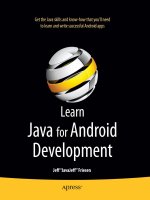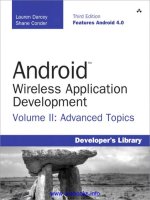Learn Java for Android Development Second Edition doc
Bạn đang xem bản rút gọn của tài liệu. Xem và tải ngay bản đầy đủ của tài liệu tại đây (4.84 MB, 767 trang )
www.it-ebooks.info
Learn Java for Android
Development
Second Edition
Je Friesen
Apress
www.it-ebooks.info
Learn Java for Android Development
Copyright © 2013 by Je Friesen
is work is subject to copyright. All rights are reserved by the Publisher, whether the whole or part of the material
is concerned, specically the rights of translation, reprinting, reuse of illustrations, recitation, broadcasting,
reproduction on microlms or in any other physical way, and transmission or information storage and retrieval,
electronic adaptation, computer software, or by similar or dissimilar methodology now known or hereafter developed.
Exempted from this legal reservation are brief excerpts in connection with reviews or scholarly analysis or material
supplied specically for the purpose of being entered and executed on a computer system, for exclusive use by the
purchaser of the work. Duplication of this publication or parts thereof is permitted only under the provisions of the
Copyright Law of the Publisher's location, in its current version, and permission for use must always be obtained from
Springer. Permissions for use may be obtained through RightsLink at the Copyright Clearance Center. Violations are
liable to prosecution under the respective Copyright Law.
Trademarked names, logos, and images may appear in this book. Rather than use a trademark symbol with every
occurrence of a trademarked name, logo, or image we use the names, logos, and images only in an editorial fashion
and to the benet of the trademark owner, with no intention of infringement of the trademark.
e use in this publication of trade names, trademarks, service marks, and similar terms, even if they are not identied
as such, is not to be taken as an expression of opinion as to whether or not they are subject to proprietary rights.
While the advice and information in this book are believed to be true and accurate at the date of publication, neither
the authors nor the editors nor the publisher can accept any legal responsibility for any errors or omissions that may
be made. e publisher makes no warranty, express or implied, with respect to the material contained herein.
President and Publisher: Paul Manning
Lead Editor: Steve Anglin
Developmental Editors: Tom Welsh and Matthew Moodie
Technical Reviewers: Paul Connolly, Chad Darby and Onur Cinar
Editorial Board: Steve Anglin, Mark Beckner, Ewan Buckingham, Gary Cornell, Louise Corrigan, Morgan Ertel,
Jonathan Gennick, Jonathan Hassell, Robert Hutchinson, Michelle Lowman, James Markham,
Matthew Moodie, Je Olson, Jerey Pepper, Douglas Pundick, Ben Renow-Clarke, Dominic Shakeshaft,
Gwenan Spearing, Matt Wade, Tom Welsh
Coordinating Editor: Katie Sullivan
Copy Editor: Deanna K. Hegle
Compositor: SPi Global
Indexer: SPi Global
Artist: SPi Global
Cover Designer: Anna Ishchenko
Distributed to the book trade worldwide by Springer Science+Business Media New York, 233 Spring Street, 6th Floor,
New York, NY 10013. Phone 1-800-SPRINGER, fax (201) 348-4505, e-mail , or visit
www.springeronline.com. Apress Media, LLC is a California LLC and the sole member (owner) is Springer Science +
Business Media Finance Inc (SSBM Finance Inc). SSBM Finance Inc is a Delaware corporation.
For information on translations, please e-mail , or visit www.apress.com.
A
press and friends of ED books may be purchased in bulk for academic, corporate, or promotional use. eBook
versions and licenses are also available for most titles. For more information, reference our Special Bulk Sales–eBook
Licensing web page at www.apress.com/bulk-sales.
Any source code or other supplementary materials referenced by the author in this text is available to readers at
www.apress.com. For detailed information about how to locate your book’s source code, go to
www.apress.com/source-code/.
ISBN 978-1-4302-5722-6
ISB
N 978-1-4302-5723-3
(eBook)
www.it-ebooks.info
To Amaury.
www.it-ebooks.info
v
Contents at a Glance
About the Author xvii
About the Technical Reviewers xix
Acknowledgments xxi
Introduction xxiii
Chapter 1: Getting Started With Java N 1
Chapter 2: Learning Language Fundamentals N 21
Chapter 3: Discovering Classes and Objects N 63
Chapter 4: Discovering Inheritance, Polymorphism, and Interfaces N 105
Chapter 5: Mastering Advanced Language Features Part 1 N 153
Chapter 6: Mastering Advanced Language Features Part 2 N 197
Chapter 7: Exploring the Basic APIs Part 1 N 247
Chapter 8: Exploring the Basic APIs Part 2 N 279
Chapter 9: Exploring the Collections Framework N 327
Chapter 10: Exploring Additional Utility APIs N 407
Chapter 11: Performing Classic I/O N 449
Chapter 12: Accessing Networks N 525
www.it-ebooks.info
vi Contents at a Glance
Chapter 13: Migrating to New I/O N 561
Chapter 14: Accessing Databases N 603
Appendix A: Solutions to Exercises N 643
Appendix B: Four of a Kind N 713
Index 735
www.it-ebooks.info
vii
Contents
About the Author xvii
About the Technical Reviewers xix
Acknowledgments xxi
Introduction xxiii
Chapter 1: Getting Started With Java N 1
What Is Java? 2
Java Is a Language 2
Java Is a Platform 4
Java SE, Java EE, Java ME, and Android 5
Installing and Exploring the JDK 6
Installing and Exploring the Eclipse IDE 12
Overview of Java APIs 16
Language-Support and Other Language-Oriented APIs 17
Collections-Oriented APIs 17
Additional Utility APIs 17
Classic I/O APIs 17
Networking APIs 18
www.it-ebooks.info
viii Contents
New I/O APIs 18
Database APIs 18
Summary 19
Chapter 2: Learning Language Fundamentals N 21
Learning Comments 21
Single-Line Comments 22
Multiline Comments 22
Javadoc Comments 23
Learning Identifiers 25
Learning Types 26
Primitive Types 26
User-Defined Types 28
Array Types 28
Learning Variables 29
Learning Expressions 30
Simple Expressions 30
Compound Expressions 34
Learning Statements 46
Assignment Statements 46
Decision Statements 47
Loop Statements 51
Break and Labeled Break Statements 56
Continue and Labeled Continue Statements 58
Summary 60
Chapter 3: Discovering Classes and Objects N 63
Declaring Classes and Instantiating Objects 63
Declaring Classes 64
Instantiating Objects with the New Operator and a Constructor 64
Specifying Constructor Parameters and Local Variables 65
www.it-ebooks.info
ixContents
Encapsulating State and Behaviors 69
Representing State via Fields 70
Representing Behaviors via Methods 75
Hiding Information 84
Initializing Classes and Objects 89
Class Initializers 89
Instance Initializers 91
Initialization Order 93
Collecting Garbage 96
Revisiting Arrays 99
Summary 104
Chapter 4: Discovering Inheritance, Polymorphism, and Interfaces N 105
Building Class Hierarchies 105
Extending Classes 106
The Ultimate Superclass 112
Composition 122
The Trouble with Implementation Inheritance 122
Changing Form 126
Upcasting and Late Binding 127
Abstract Classes and Abstract Methods 131
Downcasting and Runtime Type Identification 133
Covariant Return Types 136
Formalizing Class Interfaces 139
Declaring Interfaces 139
Implementing Interfaces 140
Extending Interfaces 144
Why Use Interfaces? 146
Summary 152
www.it-ebooks.info
x Contents
Chapter 5: Mastering Advanced Language Features Part 1 N 153
Mastering Nested Types 153
Static Member Classes 153
Nonstatic Member Classes 157
Anonymous Classes 161
Local Classes 164
Interfaces within Classes 166
Mastering Packages 167
What Are Packages? 168
The Package Statement 169
The Import Statement 169
Searching for Packages and Types 170
Playing with Packages 172
Packages and JAR Files 176
Mastering Static Imports 177
Mastering Exceptions 179
What Are Exceptions? 179
Representing Exceptions in Source Code 179
Throwing Exceptions 184
Handling Exceptions 187
Performing Cleanup 190
Summary 195
Chapter 6: Mastering Advanced Language Features Part 2 N 197
Mastering Assertions 197
Declaring Assertions 198
Using Assertions 199
Avoiding Assertions 205
Enabling and Disabling Assertions 206
www.it-ebooks.info
xiContents
Mastering Annotations 207
Discovering Annotations 207
Declaring Annotation Types and Annotating Source Code 210
Processing Annotations 215
Mastering Generics 217
Collections and the Need for Type Safety 217
Generic Types 220
Generic Methods 229
Arrays and Generics 232
Mastering Enums 234
The Trouble with Traditional Enumerated Types 234
The Enum Alternative 235
The Enum Class 241
Summary 245
Chapter 7: Exploring the Basic APIs Part 1 N 247
Exploring the Math APIs 247
Math and StrictMath 247
BigDecimal 255
BigInteger 260
Exploring String Management 264
String 264
StringBuffer and StringBuilder 268
Obtaining Package Information 270
Summary 276
Chapter 8: Exploring the Basic APIs Part 2 N 279
Exploring the Primitive Type Wrapper Classes 279
Boolean 280
Character 281
Float and Double 282
Integer, Long, Short, and Byte 286
Number 288
www.it-ebooks.info
xii Contents
Exploring Threads 288
Runnable and Thread 289
Thread Synchronization 298
Exploring System Capabilities 314
System 314
Runtime and Process 319
Summary 324
Chapter 9: Exploring the Collections Framework N 327
Exploring Collections Framework Fundamentals 327
Comparable Versus Comparator 328
Iterable and Collection 330
Exploring Lists 337
ArrayList 341
LinkedList 342
Exploring Sets 344
TreeSet 344
HashSet 346
EnumSet 350
Exploring Sorted Sets 353
Exploring Navigable Sets 361
Exploring Queues 364
PriorityQueue 365
Exploring Deques 368
ArrayDeque 372
Exploring Maps 373
TreeMap 377
HashMap 378
IdentityHashMap 384
EnumMap 386
www.it-ebooks.info
xiiiContents
Exploring Sorted Maps 387
Exploring Navigable Maps 390
Exploring the Arrays and Collections Utility APIs 394
Exploring the Legacy Collection APIs 398
Summary 404
Chapter 10: Exploring Additional Utility APIs N 407
Exploring the Concurr
ency Utilities 407
Executors 407
Synchronizers 417
Concurrent Collections 420
Locks 422
Atomic Variables 425
Exploring the Date Class 426
Exploring the Formatter Class 428
Exploring the Random Class 430
Exploring the Scanner Class 432
Exploring the ZIP and JAR APIs 434
Exploring the ZIP API 435
Exploring the JAR API 442
Summary 447
Chapter 11: Performing Classic I/O N 449
Working with the File API 449
Working with the RandomAccessFile API 462
Working with Streams 473
Stream Classes Overview 474
OutputStream and InputStream 475
ByteArrayOutputStream and ByteArrayInputStream 478
FileOutputStream and FileInputStream 479
PipedOutputStream and PipedInputStream 482
FilterOutputStream and FilterInputStream 485
www.it-ebooks.info
xiv Contents
BufferedOutputStream and BufferedInputStream 493
DataOutputStream and DataInputStream 494
Object Serialization and Deserialization 496
PrintStream 510
Working with Writers and Readers 511
Writer and Reader Classes Overview 512
Writer and Reader 514
OutputStreamWriter and InputStreamReader 514
FileWriter and FileReader 516
Summary 524
Chapter 12: Accessing Networks N 525
Accessing Networks via Sockets 526
Socket Addresses 528
Socket Options 529
Socket and ServerSocket 530
DatagramSocket and MulticastSocket 536
Accessing Networks via URLs 543
URL and URLConnection 543
URLEncoder and URLDecoder 547
Accessing Network Interfaces and Interface Addresses 549
Managing Cookies 555
Summary 559
Chapter 13: Migrating to New I/O N 561
Working with Buffers 562
Buffer and Its Children 562
Buffers in Depth 566
Working with Channels 575
Channel and Its Children 576
Channels in Depth 580
www.it-ebooks.info
xvContents
Working With Regular Expressions 589
Pattern, PatternSyntaxException, and Matcher 589
Character Classes 593
Capturing Groups 594
Boundary Matchers and Zero-Length Matches 595
Quantifiers 596
Practical Regular Expressions 598
Summary 601
Chapter 14: Accessing Databases N 603
Introducing Java DB 604
Java DB Installation and Configuration 605
Java DB Demos 607
Java DB Command-Line Tools 609
Introducing SQLite 611
Accessing Databases via JDBC 613
Data Sources, Drivers, and Connections 613
Exceptions 616
Statements 620
Metadata 633
Summary 639
Appendix A: Solutions to Exercises N 643
Chapter 1: Getting Started with Java 643
Chapter 2: Learning Language Fundamentals 644
Chapter 3: Discovering Classes and Objects 647
Chapter 4: Discovering Inheritance, Polymorphism, and Interfaces 651
Chapter 5: Mastering Advanced Language Features Part 1 659
Chapter 6: Mastering Advanced Language Features Part 2 666
Chapter 7: Exploring the Basic APIs Part 1 671
Chapter 8: Exploring the Basic APIs Part 2 676
Chapter 9: Exploring the Collections Framework 679
www.it-ebooks.info
xvi Contents
Chapter 10: Exploring Additional Utility APIs 686
Chapter 11: Performing Classic I/O 689
Chapter 12: Accessing Networks 698
Chapter 13: Migrating to New I/O 704
Chapter 14: Accessing Databases 709
Appendix B: Four of a Kind N 713
Understanding Four of a Kind
713
Modeling Four of a Kind in Pseudocode 714
Converting Pseudocode to Java Code 715
Compiling, Running, and Distributing FourOfAKind 731
Index 735
www.it-ebooks.info
xvii
About the Author
Jeff Friesen is a freelance tutor and software developer with an
emphasis on Java (and now Android). In addition to writing this book,
Jeff has written numerous articles on Java and other technologies for
JavaWorld (www.javaworld.com), informIT (www.informit.com), java.net,
DevSource (www.devsource.com), SitePoint (www.sitepoint.com),
BuildMobile (www.buildmobile.com), and JSPro (www.jspro.com). Jeff
can be contacted via his web site at tutortutor.ca.
www.it-ebooks.info
xix
About the Technical
Reviewers
Paul Connolly is the Director of Engineering for Atypon Systems’
RightSuite product line. RightSuite is an enterprise access-control and
commerce solution used by many of the world’s largest publishing
and media companies. Paul enjoys designing and implementing
high-performance, enterprise-class software systems. He is also an
active contributor in the open-source community.
Prior to joining Atypon Systems, Paul worked as a senior software
engineer at Standard & Poor’s where he designed and developed key
communications systems. Paul is a Sun Certified Java Programmer,
Sun Certified Business Component Developer, and a Sun Certified Web
Component Developer. Paul lives in Rochester, NY, with his wife Marina
and daughter Olivia.
Chád Darby is an author, instructor and speaker in the Java development
world. As a recognized authority on Java applications and architectures,
he has presented technical sessions at software development conferences
worldwide. In his 15 years as a professional software architect, he’s
had the opportunity to work for Blue Cross/Blue Shield, Merck, Boeing,
Northrop Grumman, and a handful of startup companies.
Chád is a contributing author to several Java books, including Professional
Java E-Commerce (Wrox Press), Beginning Java Networking (Wrox Press),
and XML and Web Services Unleashed (Sams Publishing). Chád has
Java certifications from Sun Microsystems and IBM. He holds a B.S. in
Computer Science from Carnegie Mellon University.
You can read Chád’s blog at www.luv2code.com and follow him on
T
witter @darbyluvs2code.
www.it-ebooks.info
xx About the Technical Reviewers
Onur Cinar is the author of Android Apps with Eclipse, and Pro
Android C++ with the NDK books from Apress. He has over 17 years
of experience in design, development, and management of large scale
complex software projects, primarily in mobile and telecommunication
space. His expertise spans VoIP, video communication, mobile
applications, grid computing, and networking technologies on diverse
platforms. He has been actively working with the Android platform
since its beginning. He has a B.S. degree in Computer Science from
Drexel University in Philadelphia, PA. He is currently working at the
Skype division of Microsoft as the Sr. Product Engineering Manager for
the Skype client on Android platform.
www.it-ebooks.info
xxi
Acknowledgments
I thank Steve Anglin for contacting me to write this book; Katie Sullivan for guiding me through
the various aspects of this project; Tom Welsh and Matthew Moodie for helping me with the
development of my chapters; and Paul Connolly, Chád Darby, and Onur Cinar for their diligence in
catching various flaws that would otherwise have made it into this book.
www.it-ebooks.info
xxiii
Introduction
Smartphones and tablets are all the rage these days. Their popularity is largely due to their ability to
run apps. Although the iPhone and iPad with their growing collection of Objective-C-based apps had
a head start, Android-based smartphones and tablets with their growing collection of Java-based
apps are proving to be a strong competitor.
Not only are many iPhone/iPad app developers making money by selling their apps, many Android
app developers are also making money by selling similar apps. According to tech web sites such
as The Register (www.theregister.co.uk/), some Android app developers are making lots of money
(www.theregister.co.uk/2010/03/02/android_app_profit/).
In today’s challenging economic climate, perhaps you would like to try your hand at developing
Android apps and make some money. If you have good ideas, perseverance, and some artistic
talent (or perhaps know some talented individuals), you are already part of the way toward achieving
this goal.
Tip A good reason to consider Android app development over iPhone/iPad app development is the lower
startup costs that you will incur with Android. For example, you don’t need to purchase a Mac on which to
develop Android apps (a Mac is required for developing iPhone/iPad apps); your existing Windows, Linux, or
Unix machine will do nicely.
Most important, you will need to possess a solid understanding of the Java language and
foundational application programming interfaces (APIs) before jumping into Android. After all,
Android apps are written in Java and interact with many of the standard Java APIs (e.g., threading
and input/output APIs).
I wrote Learn Java for Android Development to give you a solid Java foundation that you can later
extend with knowledge of Android architecture, API, and tool specifics. This book will give you a
strong grasp of the Java language and many important APIs that are fundamental to Android apps
and other Java applications. It will also introduce you to key development tools.
www.it-ebooks.info
xxiv Introduction
Book Organization
The first edition of this book was organized into 10 chapters and one appendix. The second edition
is organized into 14 chapters and three appendixes. Each chapter in each edition offers a set of
exercises that you should complete to get the most benefit from its content. Their solutions are
presented in an appendix.
In Chapter 1 I introduce you to Java by first focusing on Java’s dual nature (language and platform).
I then briefly introduce you to Oracle’s Java SE, Java EE, and Java ME editions of the Java
development software, as well as Google’s Android edition. You next learn how to download and
install the Java SE Development Kit (JDK) and learn some Java basics by developing and playing
with a pair of simple Java applications. After a brief introduction to the Eclipse IDE, you receive an
overview of the various APIs covered in this book.
In Chapter 2 I start you on an in-depth journey of the Java language by focusing on language
fundamentals. You learn about comments, identifiers (and reserved words), types, variables,
expressions (and literals), and statements.
In Chapter 3 I continue your journey by focusing on classes and objects. You learn how to declare a
class and instantiate objects from the class, how to declare fields within the class and access these
fields, how to declare methods within the class and call them, how to initialize classes and objects,
and how to get rid of objects when they are no longer needed. You also learn more about arrays,
which are first introduced in Chapter 2.
In Chapter 4 I add to Chapter 3’s pool of object-based knowledge by introducing you to language
features that take you from object-based applications to object-oriented applications. Specifically,
you learn about features related to inheritance, polymorphism, and interfaces. While exploring
inheritance, you learn about Java’s ultimate superclass. Also, while exploring interfaces, you
discover why they were included in the Java language; interfaces are not merely a workaround for
Java’s lack of support for multiple implementation inheritance but serve a higher purpose.
In Chapter 5 I introduce you to four categories of advanced language features: nested types,
packages, static imports, and exceptions.
In Chapter 6 I introduce you to four additional advanced language feature categories: assertions,
annotations, generics, and enums.
In Chapter 7 I begin a trend that focuses more on APIs than language features. In this chapter I
first introduce you to many of Java’s math-oriented types (e.g., Math, StrictMath, BigDecimal, and
BigInteger) and then introduce you to its string-oriented types (e.g., String, StringBuffer, and
StringBuilder). Finally, you explore the Package class for obtaining package information.
In Chapter 8 I continue to explore Java’s basic APIs by focusing on primitive type wrapper classes,
threading, and system-oriented APIs.
In Chapter 9 I focus exclusively on Java’s Collections Framework, which provides you with a solution
for organizing objects in lists, sets, queues, and maps. You also learn about collection-oriented utility
classes and review Java’s legacy utility types.
In Chapter 10 I continue to explore Java’s utility APIs by introducing you to Concurrency Utilities, the
Date class (for representing time), the Formatter class (for formatting data items), the Random class
(for generating random numbers), the Timer and TimerTask classes (for occasionally or repeatedly
executing tasks), and the APIs for working with ZIP and JAR files.
www.it-ebooks.info
xxvIntroduction
Chapter 11 is all about classic input/output (I/O), seen largely from a file perspective. In this chapter,
you explore classic I/O in terms of the File class, RandomAccessFile class, various stream classes,
and various writer/reader classes. My discussion of stream I/O includes coverage of Java’s object
serialization and deserialization mechanisms.
In Chapter 12 I continue to explore classic I/O by focusing on networks. You learn about the Socket,
ServerSocket, DatagramSocket, and MulticastSocket classes along with related types. You also learn
about the URL class for achieving networked I/O at a higher level. After learning about the low-level
NetworkInterface and InterfaceAddress classes, you explore cookie management in terms of the
CookieHandler and CookieManager classes and the CookiePolicy and CookieStore interfaces.
In Chapter 13 I introduce you to New I/O. You learn about buffers, channels, and regular expressions
in this chapter. I would have loved to cover selectors and charsets as well but could not do so for
lack of space. To cover selectors, I would also have had to discuss socket channels, but I could only
cover file channels. However, Chapter 11 does give you a small taste of charsets.
In Chapter 14 I wrap up the chapter portion of this book by focusing on databases. You first learn
about the Java DB and SQLite database products and then explore JDBC for communicating with
databases created via these products.
In Appendix A I present solutions to all exercises in Chapters 1 through 14.
In Appendix B I introduce you to application development in the context of Four of a Kind, a
console-based card game.
In Appendix C, which is available as a separate PDF file that’s bundled with this book’s code,
I introduce you to advanced APIs (e.g., Reflection and References) as well as APIs that might not
be as useful in an Android app context (e.g., Preferences—Android offers its own solution.)
Note You can download this book’s source code by pointing your web browser to
www.apress.com/book/view/1430257226 and clicking the Source Code tab followed by the Download
Now link.
First Edition vs. Second Edition
The first edition of this book debuted in September 2010. I’m generally pleased with the first edition,
and I thank everyone who purchased it. However, as was pointed out to me on multiple occasions,
the first edition is flawed. As well as small technical errors, there are certain organizational and other
issues that got by me during that book’s development.
For starters, I should not have introduced the Four of a Kind card game in Chapter 1. It was too
complicated for many readers to encounter at this point. As a result, I’ve moved the game to
Appendix B so as not to overwhelm Java beginners.
Also, I attempted to cover language fundamentals (e.g., statements and expressions) with the basics
of classes and objects in the same chapter. Although some people appreciated this approach, it
turned out to be too confusing for beginners; I apologize to readers who felt this way. In the second
edition I separate these aspects of the Java language to (hopefully) sort out this problem. In Chapter 2
I focus on statements, expressions, and other non-class/non-object fundamentals; in Chapter 3
I focus on classes and objects.
www.it-ebooks.info
xxvi Introduction
Another issue was the inclusion of complex APIs that are either infrequently used when developing
Android apps or are mostly irrelevant to Android developers. Examples include References,
Reflection, Preferences, and Internationalization. I moved these APIs to Appendix C so that I could
cover simpler (and possibly more useful) APIs such as ZIP and Timer. (I also included additional new
content in Appendix C.)
While writing the first edition, I planned to go further by covering Java’s support for networking and
database access (via JDBC), security, XML, New I/O, and so on. I foolishly presented a plan to write
six free chapters, but only managed to complete portions of three chapters.
Unfortunately, my original plan for six free chapters was flawed. For instance, I planned to write a
free chapter on networking that would come after a free chapter on New I/O. That wasn’t a good
organization because New I/O includes socket channels, and so the networking chapter should have
preceded a chapter on New I/O.
Also, I’ve learned (via various blogs about Android and security) that Java’s security features aren’t
as necessary in an Android context. Because this book partly focuses on presenting the most useful
Java APIs for subsequent use in an Android context, coverage of Java’s security APIs is probably
not as important (although I could be wrong).
Note There are no free chapters to supplement the second edition. However, Appendix C is a freebie.
Also, I might eventually offer some additional material (perhaps coverage of socket channels, selectors, and
charsets) on my web site (see
What Comes Next?
After you complete this book, I recommend that you obtain a copy of Beginning Android 4 by Grant
Allen (Apress, 2012) and start learning how to develop Android apps. In that book, you learn Android
basics and how to create “innovative and salable applications for Android 4 mobile devices.” Rather
than give a few superficial details of Android development, Learn Java for Android Development
Second Edition concentrates on teaching you the Java language and APIs such as Collections
that you will need to use in your apps. If you don’t first understand Java, how can you proceed to
understand Android?
Note I also recommend that you check out the second edition of Android Recipes
(see www.apress.com/9781430246145). Although the content of that book largely contains independent
recipes for learning all kinds of things about Android, Chapter 1 contains a summarized and rapid introduction
to Android app development. You will learn much about Android basics from reading that chapter.
Thanks for purchasing my book. I hope you find it a helpful preparation for, and I wish you lots of
success in achieving, a satisfying and lucrative career as an Android app developer.
www.it-ebooks.info
1
Chapter 1
Getting Started With Java
Android is Google’s software stack for mobile devices. This stack consists of applications
(or apps as they are commonly called), a virtual machine (software-based processor and associated
environment) in which apps run, middleware (software that sits on top of the operating system and
provides various services to the virtual machine and its apps), and a Linux-based operating system.
Android apps are written in Java and use various Java Application Program Interfaces (APIs).
Because you will want to write your own apps but may be unfamiliar with the Java language and
these APIs, this book teaches you about Java as a first step into app development. It provides you
with the fundamentals of the Java language and Java APIs that are useful when developing apps.
Note This book illustrates Java concepts via non-Android Java applications. It’s easier for beginners
to grasp these applications than corresponding Android apps.
An API refers to an interface that an application’s code uses to communicate with other code, which is
typically stored in some kind of software library. For more information on this term, check out Wikipedia’s
“Application programming interface” topic ( />programming_interface).
This chapter sets the stage for teaching you the essential Java concepts that you need to
understand before you embark on your Android app development career. I first answer the “What is
Java?” question. I next show you how to install the Java SE Development Kit (JDK), and introduce
you to JDK tools for compiling and running Java applications.
After showing you how to install and use the open source Eclipse IDE (Integrated Development
Environment) so that you can more easily (and more quickly) develop Java applications (and,
eventually, Android apps), I provide you with a high-level overview of various Java APIs that you can
access from your Java applications and Android apps. In subsequent chapters, you’ll explore these
and other useful APIs in greater detail.
J. Friesen, Learn Java for Android Development
© Jeff Friesen 2013
www.it-ebooks.info









